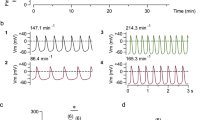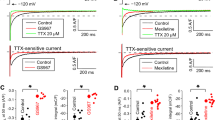Abstract
4-aminopyridine (4-AP) is commonly used to block the transient outward potassium current, Ito, in cardiac and noncardiac tissues. In the present work, we found that 4-AP inhibited the rapid component of the delayed rectifier potassium current, IKr, in rabbit-isolated sinoatrial node myocytes by 25% (1 mM) and 51% (5 mM) and inhibited the slow component of the delayed rectifier potassium current, IKs, in cat- isolated sinoatrial node myocytes by 39% (1 mM) and 62% (5 mM). In cat- and rabbit-isolated sinoatrial node myocytes, 4-AP activated muscarinic receptors in a voltage-dependent manner to increase the acetylcholine-activated potassium current, IKACh. In multicellular preparations of the central region of the sinoatrial node from nonreserpinized rabbits, 4-AP produced an increase in action potential overshoot, frequency, and rate of diastolic depolarization. In the presence of the β-adrenergic antagonist propranolol, 4-AP produced a marked increase in duration and a marked decrease in maximum diastolic potential and eventually, cessation of the spontaneous activity in preparations from the sinoatrial central region. In multicellular preparations from reserpinized rabbits, 4-AP produced similar effects to those observed in the presence of propranolol. We conclude that 4-AP inhibits multiple cardiac K+ currents, including Ito, IKr, and IKs, and that these activities mask IKACh activation. In addition, in multicellular preparations, 4-AP produces neurotransmitter release from the autonomic nerve terminals. These multiple effects need to be considered when using 4-AP as a “specific” Ito blocker.






Similar content being viewed by others
References
Nerbonne JM, Kass RS (2005) Molecular physiology of cardiac repolarization. Physiol Rev 85:1205–1253
Mangoni ME, Nargeot J (2008) Genesis and regulation of the heart automaticity. Physiol Rev 88:919–982
Honjo H, Lei M, Boyett MR, Kodama I (1999) Heterogeneity of 4-aminopyridine-sensitive current in rabbit sinoatrial node cells. Am J Physiol 276:H1295–H1304
Boyett MR, Honjo H, Yamamoto M, Nikmaram MR, Niwa R, Kodama I (1998) Regional differences in effects of 4-aminopyridine within the sinoatrial node. Am J Physiol 275:H1158–H1168
Navarro-Polanco RA, Sanchez-Chapula JA (1997) 4-aminopyridine activates potassium currents by activation of a muscarinic receptor in feline atrial myocytes. J Physiol 498:663–678
Mitcheson JS, Hancox JC (1999) Characteristics of a transient outward current (sensitive to 4-aminopyridine) in Ca2+-tolerant myocytes isolated from the rabbit atrioventricular node. Pflugers Arch 438:68–78
Ridley JM, Milnes JT, Zhang YH, Witchel HJ, Hancox JC (2003) Inhibition of HERG K+ current and prolongation of the guinea-pig ventricular action potential by 4-aminopyridine. J Physiol 549:667–672
Kirpekar M, Kirpekar SM, Prat JC (1977) Effect of 4-aminopyridine on release of noradrenaline from the perfused cat spleen by nerve stimulation. J Physiol 272:517–528
Yanagisawa T, Satoh K, Taira N (1978) Excitation of autonomic nerves by 4-aminopyridine in the isolated, blood-perfused sino-atrial node preparation of the dog. Eur J Pharmacol 49:189–192
Isenberg G, Klockner U (1982) Calcium tolerant ventricular myocytes prepared by preincubation in a "KB medium". Pflugers Arch 395:6–18
Sanchez-Chapula J, Elizalde A (1987) Characterization of the effects of histamine on the transmembrane electrical activity of guinea-pig and rabbit SA- and AV-node cells. Naunyn Schmiedebergs Arch Pharmacol 336:218–223
Benavides-Haro DE, Navarro-Polanco RA, Sanchez-Chapula JA (2003) The cholinomimetic agent bethanechol activates IK(ACh) in feline atrial myocytes. Naunyn Schmiedebergs Arch Pharmacol 368:309–315
Verheijck EE, van Ginneken AC, Bourier J, Bouman LN (1995) Effects of delayed rectifier current blockade by E-4031 on impulse generation in single sinoatrial nodal myocytes of the rabbit. Circ Res 76:607–615
Kodama I, Boyett MR, Nikmaram MR, Yamamoto M, Honjo H, Niwa R (1999) Regional differences in effects of E-4031 within the sinoatrial node. Am J Physiol 276:H793–H802
Glover WE (1981) Cholinergic effect of 4-aminopyridine and adrenergic effect of 4-methyl-2-aminopyridine in cardiac muscle. Eur J Pharmacol 71:21–31
Torres-Jacome J, Tejeda-Chavez HR, Rodriguez-Menchaca AA, Sanchez-Chapula JA, Navarro-Polanco RA (2006) The D3-dopaminergic agonist 7-hydroxy-dipropylaminotetralin (7-OH-DPAT) increases cardiac action potential duration and blocks human ether-a-go-go-related gene K+ channel. J Cardiovasc Pharmacol 47:656–662
Elizalde A, Barajas H, Navarro-Polanco R, Sanchez-Chapula J (1999) Frequency-dependent effects of 4-aminopyridine and almokalant on action-potential duration of adult and neonatal rabbit ventricular muscle. J Cardiovasc Pharmacol 33:352–359
Drici MD, Diochot S, Terrenoire C, Romey G, Lazdunski M (2000) The bee venom peptide tertiapin underlines the role of I(KACh) in acetylcholine-induced atrioventricular blocks. Br J Pharmacol 131:569–577
Kitamura H, Yokoyama M, Akita H, Matsushita K, Kurachi Y, Yamada M (2000) Tertiapin potently and selectively blocks muscarinic K(+) channels in rabbit cardiac myocytes. J Pharmacol Exp Ther 293:196–205
Jin W, Lu Z (1998) A novel high-affinity inhibitor for inward-rectifier K+ channels. Biochemistry 37:13291–13299
Kanjhan R, Coulson EJ, Adams DJ, Bellingham MC (2005) Tertiapin-Q blocks recombinant and native large conductance K+ channels in a use-dependent manner. J Pharmacol Exp Ther 314:1353–1361
Furukawa Y, Saegusa K, Chiba S (1985) The mode of action of 4-aminopyridine on the chronotropic and inotropic responses in the isolated, blood-perfused dog heart. Eur J Pharmacol 114:317–323
Cena V, Garcia AG, Gonzalez-Garcia C, Kirpekar SM (1985) Ion dependence of the release of noradrenaline by tetraethylammonium and 4-aminopyridine from cat splenic slices. Br J Pharmacol 84:299–308
Lei M, Honjo H, Kodama I, Boyett MR (2001) Heterogeneous expression of the delayed-rectifier K+ currents i(K, r) and i(K, s) in rabbit sinoatrial node cells. J Physiol 535:703–714
Himeno Y, Sarai N, Matsuoka S, Noma A (2008) Ionic mechanisms underlying the positive chronotropy induced by beta1-adrenergic stimulation in guinea pig sinoatrial node cells: a simulation study. J Physiol Sci 58:53–65
Matsuura H, Ehara T, Ding WG, Omatsu-Kanbe M, Isono T (2002) Rapidly and slowly activating components of delayed rectifier K(+) current in guinea-pig sino-atrial node pacemaker cells. J Physiol 540:815–830
Sridhar A, da Cunha DN, Lacombe VA, Zhou Q, Fox JJ, Hamlin RL, Carnes CA (2007) The plateau outward current in canine ventricle, sensitive to 4-aminopyridine, is a constitutive contributor to ventricular repolarization. Br J Pharmacol 152:870–879
Banyasz T, Magyar J, Szentandrassy N, Horvath B, Birinyi P, Szentmiklosi J, Nanasi PP (2007) Action potential clamp fingerprints of K+ currents in canine cardiomyocytes: their role in ventricular repolarization. Acta Physiol (Oxf) 190:189–198
Acknowledgments
The authors wish to thank Miguel Angel Flores Virgen for technical assistance, Dr. Mike Sanguinetti (University of Utah) for critical reading of the manuscript and editorial assistance, and Dr. Leonardo C. Gutierrez Chavez for support. The work was supported by FOMIX (CONACYT-México) grant number 82948 and FRABA 2008 (Universidad de Colima).
Conflict of interest
The authors declare that they have no conflict of interest.
Author information
Authors and Affiliations
Corresponding author
Additional information
Iván A. Aréchiga-Figueroa and Martin Rodríguez-Martínez contributed equally to this study
Rights and permissions
About this article
Cite this article
Aréchiga-Figueroa, I.A., Rodríguez-Martínez, M., Albarado, A. et al. Multiple effects of 4-aminopyridine on feline and rabbit sinoatrial node myocytes and multicellular preparations. Pflugers Arch - Eur J Physiol 459, 345–355 (2010). https://doi.org/10.1007/s00424-009-0734-3
Received:
Revised:
Accepted:
Published:
Issue Date:
DOI: https://doi.org/10.1007/s00424-009-0734-3




